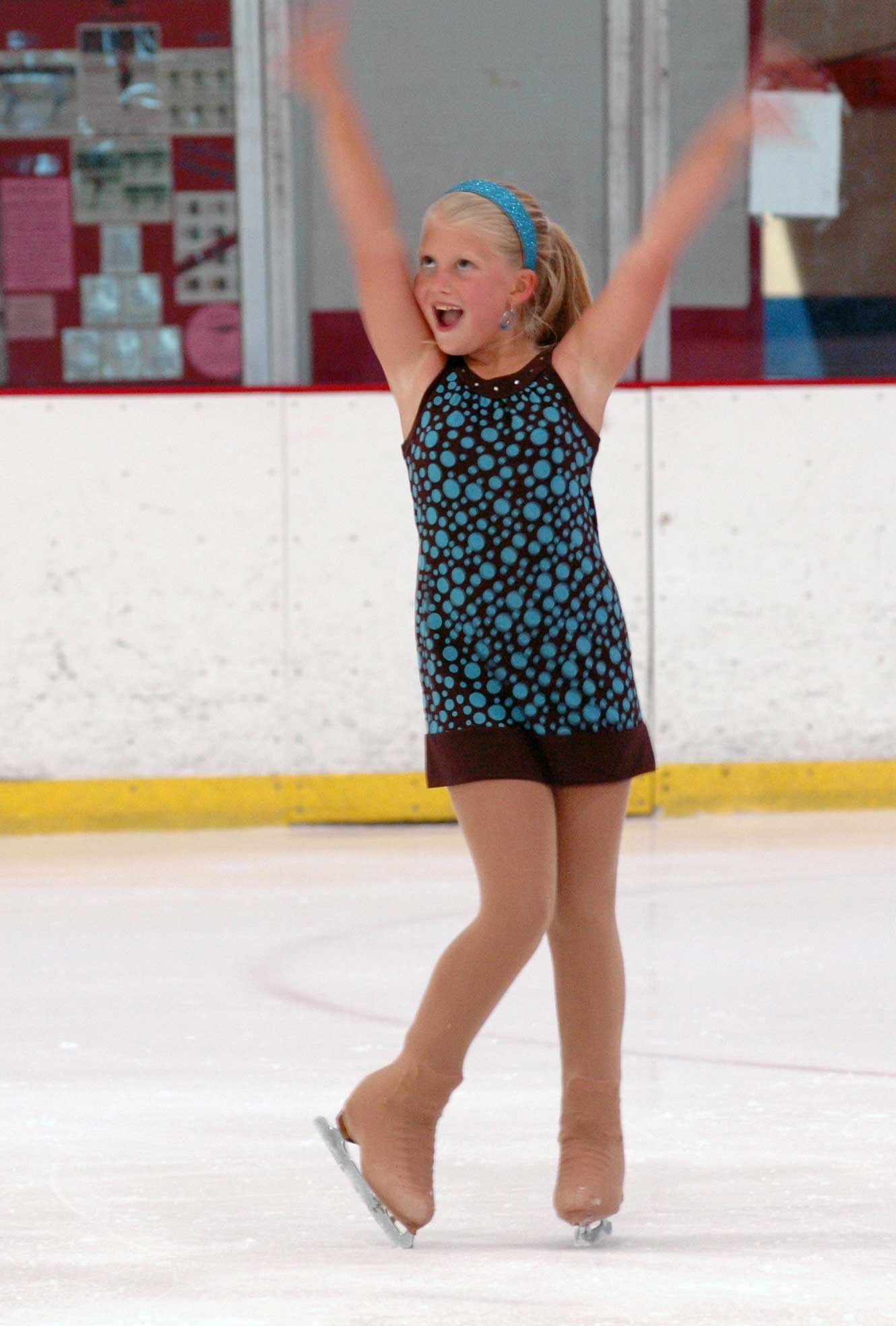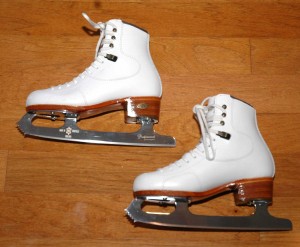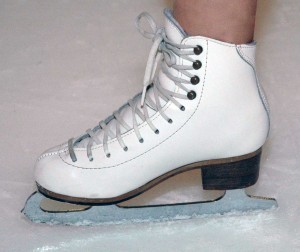
Everything You Need to Know About Buying Figure Skates
The time had finally come to fork out money to buy my daughter pretty white skates. She was about 8 and had been taking lessons twice a week for a year at Center Ice Arena. Using rental skates—stiff, brown and less-than-attractive—she had mastered swizels, one-foot glide, backwards crossovers, hockey stops, ballet jumps and increasingly advanced moves required to pass a test to move to the next level. All without complaint. Ice is hard when you fall. In those early months bruises testified to her perseverance. Her class dwindled as the difficulty increased. Now she was the only one left on the brown rentals. She was starting jumps and spins. She needed better skates. She had earned them.

.
But entering the skate shop gave me shivers, and not from the cold. I had zero knowledge of skates. I knew girls at her rink spent hundreds of dollars on a pair of skates. I did not want to get the wrong thing!
Well, Skate-girl is almost 11 now and is ready for her fifth pair of skates. We learned from each purchase we made. We paid from $5 (a lucky used bargain) to about $530. More advanced skaters pay much more. Here’s my tips for avoiding pitfalls in this expensive sport.
Know when to buy. Don’t buy until you try. Rent first. I’ve seen a lot of ads on eBay for skates worn only once or twice because the enthusiasm wore off after a couple of falls. After a year in rentals I knew my skater was committed, and I think she valued her new skates more after waiting to get them. I’ll never forget the giddiness she felt finally getting her first pair of brand new white skates.
Know where to buy. Sporting goods stores and department stores sell figure skates, but the best place to buy is a shop that specializes in figure skates. You will find more choices, better skates, and a knowledgeable salesperson. If you are lucky, your rink has such a shop. But beware: some skate shops at the rink specialize in hockey. Sales staff may have only a few figure skate models and limited knowledge of how to fit and recommend figure skates. Such a shop will be fine for a beginning pair, but you may have to go elsewhere if your daughter advances.
A good fitting technician will: ask about the skater’s weight and height; observe how she stands; measure length, width and ankles carefully; and ask about skating level. If you are not asked these questions, you need to find another fitter.
Know what to spend. Be prepared to spend $150-$250 for a entry-level set of boots and blades. You may find a deal for less, but you do not want cheapo plastic boots . . . you would be better off renting.
Know your level of skating. A more expensive skate is not better for beginners! Entry-level and recreational skaters need a boot that is more comfortable and flexible than the stiff skates made for jumpers. Beginning skates also have smaller toe picks. So don’t think you are doing your daughter any favors by buying something that is more expensive than what she needs. It is counterproductive!
Buy skates and blades as a package at first. Beginning skates come as a set with a blade already mounted (but not sharpened). As you advance you buy the boot separate from the blade so you can customize what you need. Beginners do not need (nor want) the more advanced blade, so why pay more?
Blades. When you do buy blades separately, get them slightly large. That way you can use the same blade for the next pair of boots. One blade can last through two boots if you think ahead.
Know your shoe size vs. your skate size. Shoe sizes and skate sizes are not the same thing! Each company has its own sizing system. A reputable skate shop will have rulers from all the brands they sell. For example, if you buy Riedell boots, you will be measured on a Riedell ruler. If you buy Jackson boots, you will be measured on a Jackson ruler. You can research how each company’s skates fit by visiting their website.
Online tips. If there is no good shop near you, or if you want to save money and are willing to take a bit of a risk, you can buy online. But be careful about communication and return policy. You want to buy from an online shop that converses with you by email or phone. The salesperson should ask your shoe size and have you trace around both feet on paper and then measure the drawing both in length and width. (Be sure to do both feet as one is often larger.) Give the skater’s age, skating level, height and weight. Be sure to say if feet are narrow or wide, if the arches are high or low, etc. If you buy online, be sure they do allow returns and under what conditions. You may have to pay shipping on returns.
Wear the right sock. Try the boot on with the socks you will be wearing. Most coaches recommend wearing thin socks or skate tights, not bulky socks. Regular cotton socks absorb sweat and may make feet cold. They also bunch up. You will never see them on serious skaters. Skate shops sell skate tights and skate socks, but you can also use nylons or trouser socks. Bring two pairs as you may want to try the boot with two pairs of tight-fitting socks. Some growing skaters will buy the skate a half size big to allow for growth and then wear 2 pairs or add a sole liner to start.
Try on skates properly. Once your foot is in the boot, kick the heel back firmly several times to make sure your heel is snugly against the back of the boot. Kicking the heel back is important. Make sure you lace up correctly. Start from the bottom and pull laces firmly before each crisscross. The laces should be roughly half inch apart at first but may go a bit wider and looser at top. The salesperson will help you lace up, but pay attention so you know how to do it.
Test properly. Stand and lean forward. For a child, you want to be able to wiggle a finger into the back of the boot when the skater is leaning forward. For an adult they should fit snug but not feel tight. Coaches and fitters recommend buying no more than a half size up.
Ask about heat fit. Many better boots can be “heat fit.” The shop will heat them in a special oven. You then try on the warm skates let them cool. The skates mold to your feet. We did this with my daughter’s first pair of new boots, and it worked like a charm. Do not try doing this in your oven at home. If you buy the skates at the shop, this is free. You can heat fit again later as the skater grows, but you will be charged a fee for subsequent heat-fitting.
Get waterproofing. Water is a pair of skate’s biggest enemy. Blades rust and leather rots if exposed to water. Better skates have leather soles. You can protect your investment if you have the shop waterproof them. They will charge you and it will take a couple days. They remove the blades, put on the waterproofing and let it dry, then out the blades back on. Our shop painted the skater’s name and a design on sole first, which the girls loved. It made the boots more special. I am glad we went ahead and paid extra for waterproofing. A skate-dad told me he did not know about this option when he got new skates for his daughter at a different shop. After a few months they had water damage and it was a hassle to wait until they were dried out to have it done later.
You should also periodically put Sno-Seal or similar beeswax waterproofing product on your skates.
The best price is not always the best choice. We all want a deal. But getting the correct skate and right fit is so important, it may be worth it to have a professional help you. Returns are always a hassle. You may wonder why the shop at the rink charges more than the same skate online. Good skate shops work with you for the initial fitting of the boot at no added cost. This may mean providing a sole liner, or “punching out” the leather near the ankle, or stretching the boot or heat fitting. Skate shops have special tools to fit skates. Buying skates at a shop also includes the first blade sharpening. If you buy skates online, and then take them into the shop for this work, you will pay ($10-$20 each time) for each of these services. That adds up. But no matter where you buy, it is a good idea to research skate models online before you plunk down cash. If you do buy online, many places will price match. Ask if they will throw in blade guards.
Used tips. Buying used is risky business. But I have done it successfully. Here’s some tips on buying used figure skates.

Sharpening. When you buy skates, the blades are not sharpened. Make sure you like the fit of the boot before you have the blades sharpened. Once the blades are sharpened, the return policy is usually voided. Be sure to get figure skate blades sharpened by someone who knows how to sharpen for figure skating (not hockey). Ask experienced skaters at your rink who sharpens their blades.
Break them in. You can break your skates in by wearing them around the house with the blade guards on and by skating for short sessions. If you find they still hurt after a few weeks, take them to the shop for readjustments. On my daughter’s last pair, we went back for adjustments about five times. We got the sole built up a couple times and the ankles punched out a couple times until it was right. You can also buy special blister pads or gel ankle wraps. The gel ankle sleeve was great for my daughter and worth the money. Skate shops sell these. Later we got her boots stretched for a small fee.
Take care of your skates. Every skater needs two kinds of blade protectors: hard and soft. Only put on the hard ones while walking in the skates. Never store skates with the hard plastic protectors on, or your blades will rust. I have seen blades less than a year old covered in rust because they were stored this way! After each use wipe the blades off and put on terry cloth covers on for storage. It is best to let skates air out to dry. Scratches on the leather are inevitable . . . if you want to keep your skates pretty you can buy over-the-boot tights or nylon skate covers that go over the boot. They come in a variety of colors.
Enjoy your skates.
Please let me know if you find these tips helpful or if you have additional tips to add.
Read an edited version of the these tips at eHow.
Related posts:
How to buy used figure skates
How to buy a figure skating competition dress
Figure skating gift ideas
Volleyball T-shirts and Water Bottles at Cafepress
Great Books for Boys with a Movie Out or in the Works
How to Get Free Tickets to Legoland California
That’s my beautiful daughter on skates!
Even though the rink is cold, skaters need to stay hydrated. We try not to use disposable water bottles as they are bad for the environment. Here is a bottle from Amazon that I like.
Text and all photos copyright by kpdesign, creativezazz.com






